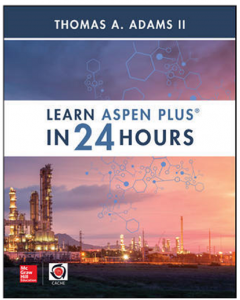Now Available!

Learn how to use Aspen Plus to solve chemical engineering problems quickly and easily!
ISBN 978-1-260-11645-8▪ 208pp ▪ 240 Illustrations
See Promotional Flyer for promotional discount code, evaluation copies, and more.
How to get it:
- McGraw-Hill (softcover, e-book): USA | Canada| Asia | Rest of World
- Access Engineering (HTML version)
- Amazon (softcover, kindle editions)
Discover how to solve challenging chemical engineering problems with Aspen Plus – in just 24 hours, and with no prior experience. Developed at McMaster University over a sevenyear period, the book features visual guides to using detailed mathematical models for a wide range of chemical process equipment, including heat exchangers, pumps, compressors, turbines, distillation columns, absorbers, strippers, and chemical reactors. Learn Aspen Plus in 24 Hours shows, step-by-step, how to configure and use Aspen Plus v9.0 and apply its powerful features to the design, operation, and optimization of safe, profitable manufacturing facilities. You will learn how to build process models and accurately simulate those models without performing tedious calculations. Divided into 12 two-hour lessons, the guide offers downloadable Aspen Plus simulations, and solutions to in-text problems.
Features:
- Contains a valuable index that lists software icons and commands used in the book
- Features helpful and time-saving links to instructional videos and technical content
- Instructs how to integrate your simulation with other supporting software such as Aspen Capital Cost Estimator, Aspen Energy Analyzer, and Microsoft Excel.
- Written by an Aspen Plus power-user and leading researcher in chemical process simulations
Table of Contents
| Title | Summary | |
|---|---|---|
| Preface | Introduction | How Aspen Plus works, sequential modular flowsheeting, and comparison to competing software |
| Tutorial 1 | Getting Started | Starting from a blank screen with no prior knowledge |
| Tutorial 2 | Physical Property Modelling | Choosing physical properties. Understanding the database. |
| Tutorial 3 | Problem Solving Tools | Design Specs and Sensitivity Analyses |
| Tutorial 4 | Heat Exchangers | HEATER, HEATX |
| Tutorial 5 | Advanced Problem Solving Tools | Utilities, GHG Emissions, Optimization |
| Tutorial 6 | Chemical Reactor Models | RSTOIC, REQUIL, RYIELD, RGIBBS, RCSTR, RPFR |
| Tutorial 7 | Equilibrium-based Distillation Models | RadFrac (in equilibrium mode) |
| Tutorial 8 | Rate-based Distillation Models | RadFrac (in rate-based mode) |
| Tutorial 9 | Custom Models and External Control | USER Blocks (Fortran Code), Microsoft Excel Connectivity |
| Tutorial 10 | Capital Cost Estimation | Aspen Capital Cost Estimator |
| Tutorial 11 | Optimal Heat Exchanger Networks | Aspen Energy Analyzer |
| Tutorial 12 | Solids Processing and Electrolyte Chemistry | Basic solids modelling. ElecNRTL. True vs Apparent components |
| Solutions | Visual solutions (using screen captures) to all problems in the text. | |
| Command Index | Visual guide to commands used in the book |
Companion Files for Download:
- Promotional Flyer (0.9MB .pdf): Ordering information and discount!
- Simulation files (3.1 MB .zip) for all tutorials in the book [see also the Software section]
- Slides from the ASEE Summer Workshop (5.1 MB .pdf) at North Carolina State, July 30-31 2017. This workshop teaches:
- How to use the book in undergraduate courses, ranging from using the entire book in courses such as Process Modelling and Simulations or Chemical Process Design
- How to use individual chapters and sections piecemeal throughout the undergraduate chemical engineering curriculum for courses such as Mass & Energy Balances, Heat Transfer, Thermodynamics, Separations, Reactions, Engineering Economics, and Optimization.
- Advice for creating active learning workshops and tutorials for your students with the book
- How to engage with students in computer labs
- How to use the book to help develop student problem solving skills
- How to assess students on their abilities such as tiered testing
- How to incorporate the material into your course teaching hierarchy.
